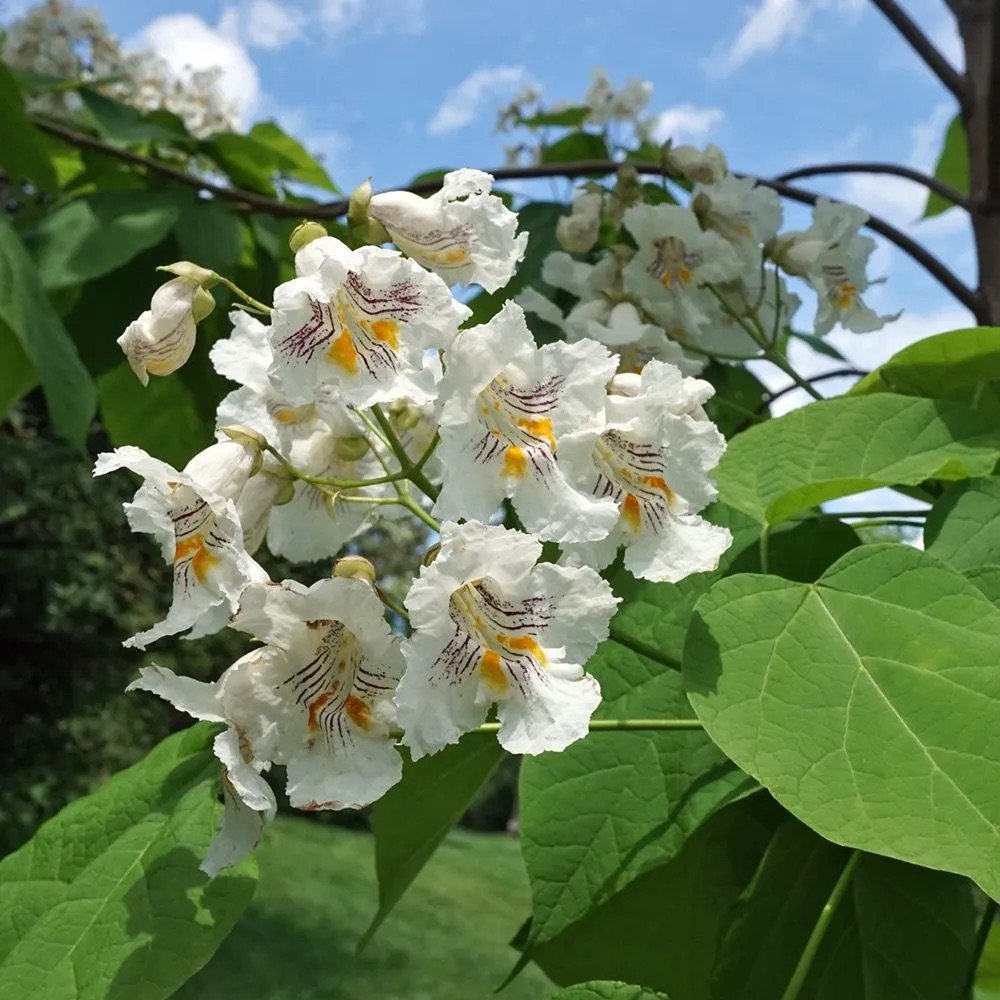Northern Catalpa
Catalpa speciosa. The northern catalpa is a large, upright tree. Its bark is a gray-brown that becomes scaly with age. Leaves are 6" to 10" long, and heart-shaped with large showy flowers that are upright in 4" to 8" clusters. The flowers are white, bell-shaped flowers with orange stripes and purple spots and stripes and a wonderful aroma shortly after black locust in the spring, loved by bumblebees. The fruit of the catalpa is a pod-like capsule, 8" to 20" inches long which is filled with winged seeds. Prefers alkaline and moist, well-drained soil. The catalpa will tolerate wet sites that experience occasional flooding as well as dry sites. It is also moderately tolerant of road salts.
Native from the lower Midwest into the southern states. It has a small native range but is commonly found from Maine to Florida since being sought after and widely distributed by settlers in the late 19th and early 20th century for use as fenceposts and railroad ties. A confusion with its not so rot resistant cousin ended all the hype. Well suited for the urban landscape, it can fix a relatively low amount of nitrogen, but it grows with incredible vigor. The wood is as durable as black locust but extremely light and easy to work with. It works well as a coppice/pollard mulch tree, ornamental, wildlife tree, lumber, or all of the above, all at once. The wood is known to be relatively brittle and branches often drop, similar to black willow. Interestingly, the leaves are one of the last to fully emerge in spring and one of the last to drop in the fall, making it particularly well suited as shade tree for passive solar.
Susceptible to verticillium wilt, leaf spots, mildew, and twig blight but no serious insect or disease problems.
Sold as bare root trees 24-36” tall.
Catalpa speciosa. The northern catalpa is a large, upright tree. Its bark is a gray-brown that becomes scaly with age. Leaves are 6" to 10" long, and heart-shaped with large showy flowers that are upright in 4" to 8" clusters. The flowers are white, bell-shaped flowers with orange stripes and purple spots and stripes and a wonderful aroma shortly after black locust in the spring, loved by bumblebees. The fruit of the catalpa is a pod-like capsule, 8" to 20" inches long which is filled with winged seeds. Prefers alkaline and moist, well-drained soil. The catalpa will tolerate wet sites that experience occasional flooding as well as dry sites. It is also moderately tolerant of road salts.
Native from the lower Midwest into the southern states. It has a small native range but is commonly found from Maine to Florida since being sought after and widely distributed by settlers in the late 19th and early 20th century for use as fenceposts and railroad ties. A confusion with its not so rot resistant cousin ended all the hype. Well suited for the urban landscape, it can fix a relatively low amount of nitrogen, but it grows with incredible vigor. The wood is as durable as black locust but extremely light and easy to work with. It works well as a coppice/pollard mulch tree, ornamental, wildlife tree, lumber, or all of the above, all at once. The wood is known to be relatively brittle and branches often drop, similar to black willow. Interestingly, the leaves are one of the last to fully emerge in spring and one of the last to drop in the fall, making it particularly well suited as shade tree for passive solar.
Susceptible to verticillium wilt, leaf spots, mildew, and twig blight but no serious insect or disease problems.
Sold as bare root trees 24-36” tall.
Catalpa speciosa. The northern catalpa is a large, upright tree. Its bark is a gray-brown that becomes scaly with age. Leaves are 6" to 10" long, and heart-shaped with large showy flowers that are upright in 4" to 8" clusters. The flowers are white, bell-shaped flowers with orange stripes and purple spots and stripes and a wonderful aroma shortly after black locust in the spring, loved by bumblebees. The fruit of the catalpa is a pod-like capsule, 8" to 20" inches long which is filled with winged seeds. Prefers alkaline and moist, well-drained soil. The catalpa will tolerate wet sites that experience occasional flooding as well as dry sites. It is also moderately tolerant of road salts.
Native from the lower Midwest into the southern states. It has a small native range but is commonly found from Maine to Florida since being sought after and widely distributed by settlers in the late 19th and early 20th century for use as fenceposts and railroad ties. A confusion with its not so rot resistant cousin ended all the hype. Well suited for the urban landscape, it can fix a relatively low amount of nitrogen, but it grows with incredible vigor. The wood is as durable as black locust but extremely light and easy to work with. It works well as a coppice/pollard mulch tree, ornamental, wildlife tree, lumber, or all of the above, all at once. The wood is known to be relatively brittle and branches often drop, similar to black willow. Interestingly, the leaves are one of the last to fully emerge in spring and one of the last to drop in the fall, making it particularly well suited as shade tree for passive solar.
Susceptible to verticillium wilt, leaf spots, mildew, and twig blight but no serious insect or disease problems.
Sold as bare root trees 24-36” tall.




